|
Oaxaca
December 2001
(For information on
traveling to Oaxaca, go to our Oaxaca
Travel Info page.)
Hernan
Cortés, the same conquistador dude who gave Montezuma his comeuppance,
founded Oaxaca (pronounced “wah-HAH-kah”) in 1529, a century before
the Pilgrims reached Plymouth. The whole sordid history of Spanish
conquest was repeated here, with ruthless suppression of Zapotec
and Mixtec Indian revolts. But the population of Oaxaca state is
still dominantly indigenous, speaking sixteen different languages (not
dialects) and only learning Spanish when and if they attend school. (See
the comments below by Eloy, our guide.)
Oaxaca City
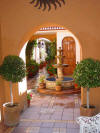 The
city prospered because of the rich valley land and the abundance of the
cochineal beetle. Cochineal, the essential source of deep red dye before
the invention of aniline dyes in the 1800s, was for centuries exported by
the millions of tons to all of Europe and the world. For example, the
beautiful red of The
city prospered because of the rich valley land and the abundance of the
cochineal beetle. Cochineal, the essential source of deep red dye before
the invention of aniline dyes in the 1800s, was for centuries exported by
the millions of tons to all of Europe and the world. For example, the
beautiful red of
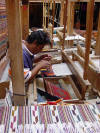 antique
Navaho rugs derives from the yarn the weavers pulled from British trade
blankets, woven and dyed in England with cochineal from the Oaxaca Valley.
Thus the wealth that built the gorgeous colonial architecture in this city
of 400,000 people, and the magnificent churches and convents was derived
from bugs! The city was the largest in Nueva España by 1800, but was
destroyed twice by earthquakes. antique
Navaho rugs derives from the yarn the weavers pulled from British trade
blankets, woven and dyed in England with cochineal from the Oaxaca Valley.
Thus the wealth that built the gorgeous colonial architecture in this city
of 400,000 people, and the magnificent churches and convents was derived
from bugs! The city was the largest in Nueva España by 1800, but was
destroyed twice by earthquakes.
 Some
of the churches and convents have been beautifully restored, especially
the ex-convent of Santo Domingo that has become the regional museum of
pre-Columbian art and archeology. All the labels were in Spanish, but we
could piece most of it together and it gave a wonderful overview of the
civilizations that succeeded each other in the Oaxaca Valley for thousands
of years before Cortés arrived and changed everything. The most famous was
Tomb Seven from Monte Albán (about 900 A.D.), with its magnificent jade
and gold filigree jewelry. But it was not until we ventured out of the
city that we discovered the Spanish influence is really just a thick
veneer on an indigenous population that is dominant in numbers, if not in
wealth. Some
of the churches and convents have been beautifully restored, especially
the ex-convent of Santo Domingo that has become the regional museum of
pre-Columbian art and archeology. All the labels were in Spanish, but we
could piece most of it together and it gave a wonderful overview of the
civilizations that succeeded each other in the Oaxaca Valley for thousands
of years before Cortés arrived and changed everything. The most famous was
Tomb Seven from Monte Albán (about 900 A.D.), with its magnificent jade
and gold filigree jewelry. But it was not until we ventured out of the
city that we discovered the Spanish influence is really just a thick
veneer on an indigenous population that is dominant in numbers, if not in
wealth.
Crafts: Oaxacan
Specialty
 For
me (Signe), the best part of the region was all the different kinds of
crafts that are made in the area, some that probably date back to the
earlier civilizations. The first day we visited shops recommended by
guidebooks and friends, buying some wonderful alebrijes
(whimsically painted carved animals). There is so much talent here that it
is hard to focus on one area. We were greatly limited by: a) living on a
boat; and b) traveling carry-on. But I gave it my best effort. The hardest
to pass up were the old ladies selling things in the tree-shaded central
square, the zócalo. One patient lady finally wore me down enough to
buy some of her wool rebozos (shawls),
because the colors were brilliant and the
prices so low. And For
me (Signe), the best part of the region was all the different kinds of
crafts that are made in the area, some that probably date back to the
earlier civilizations. The first day we visited shops recommended by
guidebooks and friends, buying some wonderful alebrijes
(whimsically painted carved animals). There is so much talent here that it
is hard to focus on one area. We were greatly limited by: a) living on a
boat; and b) traveling carry-on. But I gave it my best effort. The hardest
to pass up were the old ladies selling things in the tree-shaded central
square, the zócalo. One patient lady finally wore me down enough to
buy some of her wool rebozos (shawls),
because the colors were brilliant and the
prices so low. And
 that’s
without bargaining! Many people have so little that we just can’t bring
ourselves bargain over a dollar’s price difference. Small children were
selling carved wood letter openers and bookmarks with colorful figures of
birds or animals on top. We couldn’t resist them either. that’s
without bargaining! Many people have so little that we just can’t bring
ourselves bargain over a dollar’s price difference. Small children were
selling carved wood letter openers and bookmarks with colorful figures of
birds or animals on top. We couldn’t resist them either.
Mercado in Ocotlán
  On
Friday we hired a car and driver to take us to a weekly open market
(vegetables, not stocks!) in one of the many pueblos around Oaxaca city.
We On
Friday we hired a car and driver to take us to a weekly open market
(vegetables, not stocks!) in one of the many pueblos around Oaxaca city.
We
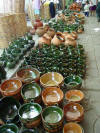 are
real market connoisseurs and have
enjoyed visiting them in Europe, Asia, and Africa, and the market in
Ocotlán was probably the best we’ve ever seen. It is not only a way for
the people to stock up on essentials
and make some pesos,
but a social occasion as well. It was full
of magnificent fruits and vegetables,
breads, are
real market connoisseurs and have
enjoyed visiting them in Europe, Asia, and Africa, and the market in
Ocotlán was probably the best we’ve ever seen. It is not only a way for
the people to stock up on essentials
and make some pesos,
but a social occasion as well. It was full
of magnificent fruits and vegetables,
breads,
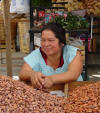 flowers
and herbs, chocolate in the raw (cacao beans; and you thought chocolate
only came in boxes and wrappers), animals on the hoof, meats, dried fish,
and much more. There were fruits we
had never seen or heard of before. The farmers come from about
ninety
miles around to sell their wares.
Eloy, our guide, was mostly of Zapotec Indian heritage (that’s his
first language), and he
dove right in
and had
us tasting everything. flowers
and herbs, chocolate in the raw (cacao beans; and you thought chocolate
only came in boxes and wrappers), animals on the hoof, meats, dried fish,
and much more. There were fruits we
had never seen or heard of before. The farmers come from about
ninety
miles around to sell their wares.
Eloy, our guide, was mostly of Zapotec Indian heritage (that’s his
first language), and he
dove right in
and had
us tasting everything.
 The
moment of truth came when
he handed samples
of the local
protein
snack, chapulines,
grasshoppers fried in
oil, with garlic, chili, and salt. They come
in three standard sizes (no, really) and only Jan was brave enough to try
one as Eloy wolfed down several. The
moment of truth came when
he handed samples
of the local
protein
snack, chapulines,
grasshoppers fried in
oil, with garlic, chili, and salt. They come
in three standard sizes (no, really) and only Jan was brave enough to try
one as Eloy wolfed down several.
  Jan
and I especially enjoyed watching the ladies with live turkeys flapping in
each hand, bargaining with buyers. The going rate for a big turkey? Ten
dollars, which is a lot of money in
these parts, Jan
and I especially enjoyed watching the ladies with live turkeys flapping in
each hand, bargaining with buyers. The going rate for a big turkey? Ten
dollars, which is a lot of money in
these parts,
 but
then you get feathers, feet, beak, gizzard, the works! It’s not exactly
your familiar frozen Butterball. The ladies were dressed in their gold
filigree earrings (much like the ones found in the Monte Albán tombs), but
then you get feathers, feet, beak, gizzard, the works! It’s not exactly
your familiar frozen Butterball. The ladies were dressed in their gold
filigree earrings (much like the ones found in the Monte Albán tombs),
 embroidered
aprons and finest (probably only) rebozos, which they used as
headdresses, shawls, baby carriers, turkey carriers, shopping
bags, etc. One lady trotted her three goats
through the middle of this children’s clothing stalls. When one of them
was being obstinate, she gave him a swift kick in the butt, right into
Jan. Life as a turisto can be dangerous! embroidered
aprons and finest (probably only) rebozos, which they used as
headdresses, shawls, baby carriers, turkey carriers, shopping
bags, etc. One lady trotted her three goats
through the middle of this children’s clothing stalls. When one of them
was being obstinate, she gave him a swift kick in the butt, right into
Jan. Life as a turisto can be dangerous!
Don’t Argue with
the Zapotec Ladies!
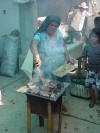 There
were so many people that some of the alleys were in gridlock. These tiny
Zapotec ladies were mighty, less than five feet tall, but solidly
built. Even Jan, the rugby player, was no match for the market ladies in a
hurry and had to wait it out. Then someone would try to get through with a
handcart full of boxes of oranges. Chaos! The other danger zone was the
hibachis set up near the butcher stalls, where people cooked the There
were so many people that some of the alleys were in gridlock. These tiny
Zapotec ladies were mighty, less than five feet tall, but solidly
built. Even Jan, the rugby player, was no match for the market ladies in a
hurry and had to wait it out. Then someone would try to get through with a
handcart full of boxes of oranges. Chaos! The other danger zone was the
hibachis set up near the butcher stalls, where people cooked the
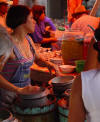 meat
they had just purchased for lunch. It was entirely too easy to get bumped
into one of the hot hibachis. Then in mid-afternoon, they could go to the
ice cream makers who had their cream and fruit in tin cans that sat in
wooden barrels of ice. Instead of a crank they spun the cans by hand for
20 minutes to freeze the ice cream. What a country! meat
they had just purchased for lunch. It was entirely too easy to get bumped
into one of the hot hibachis. Then in mid-afternoon, they could go to the
ice cream makers who had their cream and fruit in tin cans that sat in
wooden barrels of ice. Instead of a crank they spun the cans by hand for
20 minutes to freeze the ice cream. What a country!
 Each
category of merchandise has its own area of the market. All the bread
sellers were together, all the cacao bean sellers were next to the
chocolate mills, all the turkey sellers were Each
category of merchandise has its own area of the market. All the bread
sellers were together, all the cacao bean sellers were next to the
chocolate mills, all the turkey sellers were
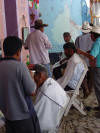 together,
all the onion ladies seated next to each other on the ground. I guess that
makes it easy to shop for the best bargain. In the midst of all of this,
the barbers had haircuts going full tilt out in the street. Three chairs,
no waiting. Dogs, kids, chickens, together,
all the onion ladies seated next to each other on the ground. I guess that
makes it easy to shop for the best bargain. In the midst of all of this,
the barbers had haircuts going full tilt out in the street. Three chairs,
no waiting. Dogs, kids, chickens,
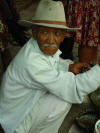 handcarts,
two large gringo tourists – all the Ocotlán world passed by, admiring
their work. handcarts,
two large gringo tourists – all the Ocotlán world passed by, admiring
their work.
Sorry to overwhelm you with
so many photos on this page, but we just couldn’t resist the colors and
the faces we saw in these wonderful markets. Especially the faces.
After the market we went to
visit the peaceful oasis of the home of artist Rodolfo Morales. He was
born in Ocotlán and donated most of his wealth to a foundation that has
built a hospital and a school, planted jacaranda trees all the way from
Oaxaca to Ocotlán, and set up computer labs and an art program with free
instruction for the children of the pueblo. Besides all this, he restored
the church and convent in the town, doing much of the work himself. There
were many examples of his paintings in the church and in his home. Quite
an interesting man who left a huge legacy when he died in January.
Pueblos and Their
Crafts
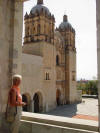 Next
on the itinerary was the pueblo of Santo Tomas de Jalieza, a town of 850
people, known for weaving with traditional backstrap looms. The women tie
one end of the loom threads to a tree. The other end goes around their
backs as they sit on the ground weaving very colorful fabrics, which they
make up into placemats, Next
on the itinerary was the pueblo of Santo Tomas de Jalieza, a town of 850
people, known for weaving with traditional backstrap looms. The women tie
one end of the loom threads to a tree. The other end goes around their
backs as they sit on the ground weaving very colorful fabrics, which they
make up into placemats,
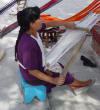 vests,
purses, backpacks, belts, hatbands, etc.
The tiny market, where each woman sold her
wares, was also open that day so I felt obligated to buy from each lady. I
had to be fair! The pieces were beautiful and they took hours to make, so
I had to support them all. Well, I did, didn’t I? vests,
purses, backpacks, belts, hatbands, etc.
The tiny market, where each woman sold her
wares, was also open that day so I felt obligated to buy from each lady. I
had to be fair! The pieces were beautiful and they took hours to make, so
I had to support them all. Well, I did, didn’t I?
There are about ten other
pueblos around Oaxaca that have their own traditional specialties: rug
weaving, black pottery, green pottery, carved animal figures,
embroideries, etc. You could visit a different town each day and just
revel in all the talent. We will just have to go back with larger duffle
bags!
Monte Albán
After all that shopping we
spent a few hours at a huge archeological site called Monte Albán. This
was our second visit to a Mexican pyramid site and the contrast between
Chichén Itzá – lost in the overwhelming Yucatan jungle – and the open site
of Monte Albán could not be greater. The Zapotecans built Monte
Albán on a big hill overlooking the valley and the modern day city of
Oaxaca, and it has a dozen or more impressive pyramids of various sizes.
The shocking thing is that this site’s heyday was ended by 600
A.D., while Chichen Itza’s was almost thousand years later. The sheer size
and age of the place makes you stand there in silence, impressed by the
achievements of these people two millennia ago.
 Our
guide, Eloy, is mostly Zapotecan and has the darkly handsome
features to prove it. He told us at one point: “My people built this Monte
Alban over two thousand years ago. The Aztecs came and went, and we are
still here. The Spanish came and went, and we are still here. Now, the
tourists . . . we are very happy to have you visit us, but . . .” We
caught his drift. Our
guide, Eloy, is mostly Zapotecan and has the darkly handsome
features to prove it. He told us at one point: “My people built this Monte
Alban over two thousand years ago. The Aztecs came and went, and we are
still here. The Spanish came and went, and we are still here. Now, the
tourists . . . we are very happy to have you visit us, but . . .” We
caught his drift.
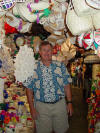 Saturday
we went to the big market in Oaxaca, which is supposed to be the best of
all. Had we not been to Ocotlán, this would have been true. It was
certainly huge, many acres with at the very least a couple thousand stalls
and individual vendors. We instantly got lost and Jan started wishing he’d
brought a GPS, just so we could find the way out. I was sure that there
were people Saturday
we went to the big market in Oaxaca, which is supposed to be the best of
all. Had we not been to Ocotlán, this would have been true. It was
certainly huge, many acres with at the very least a couple thousand stalls
and individual vendors. We instantly got lost and Jan started wishing he’d
brought a GPS, just so we could find the way out. I was sure that there
were people
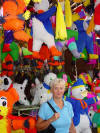 who
just live in their stalls. There are parts of
Mexico that are very Third World and not for
the faint of heart, or nose; this was one of them. As usual, we enjoyed
wandering through the chaos and observing the people who had brought their
wares in from the countryside, but it was very hot and the shady arches of
the zócalo with a cool limonada in hand sounded tempting. who
just live in their stalls. There are parts of
Mexico that are very Third World and not for
the faint of heart, or nose; this was one of them. As usual, we enjoyed
wandering through the chaos and observing the people who had brought their
wares in from the countryside, but it was very hot and the shady arches of
the zócalo with a cool limonada in hand sounded tempting.
 Hotel
El Camino Real has a weekly dinner and Oaxacan regional dance fiesta, one
of those touristy things that are still worth doing. We loved it. The
dances came from all the seven major regions of Oaxaca state, with
amazingly colorful native costumes and steps. If you go to Oaxaca, don’t
miss it. The oddest part Hotel
El Camino Real has a weekly dinner and Oaxacan regional dance fiesta, one
of those touristy things that are still worth doing. We loved it. The
dances came from all the seven major regions of Oaxaca state, with
amazingly colorful native costumes and steps. If you go to Oaxaca, don’t
miss it. The oddest part
 was
sitting at a table with four Midwestern couples traveling together, and
trying to answer their simple questions like “Where are you from?” and
“How long are you traveling?” We must have seemed like Martians to them. was
sitting at a table with four Midwestern couples traveling together, and
trying to answer their simple questions like “Where are you from?” and
“How long are you traveling?” We must have seemed like Martians to them.
 The
last treat was a woman-in-the-calle interview of Signe by a smiling
Oaxacan/Mixtec girl who was studying English. Her questions were
hilariously incoherent (“Oaxaca you like?”) but the two of them had a
great time laughing at themselves. Signe made it quite clear that “Yes,
Oaxaca she like.” The
last treat was a woman-in-the-calle interview of Signe by a smiling
Oaxacan/Mixtec girl who was studying English. Her questions were
hilariously incoherent (“Oaxaca you like?”) but the two of them had a
great time laughing at themselves. Signe made it quite clear that “Yes,
Oaxaca she like.”
Now all our lovely purchases
are packed in a duffle bag waiting to go home on December 18th.
We have persuaded a few of our friends here to try a visit to Oaxaca, and
we hope we have tempted you to visit some part of Mexico too.
Love, Signe
PS: Our
Oaxaca Travel Info page has
travel details.
Previous log
Next log
This page was last
updated on
04/13/04. |